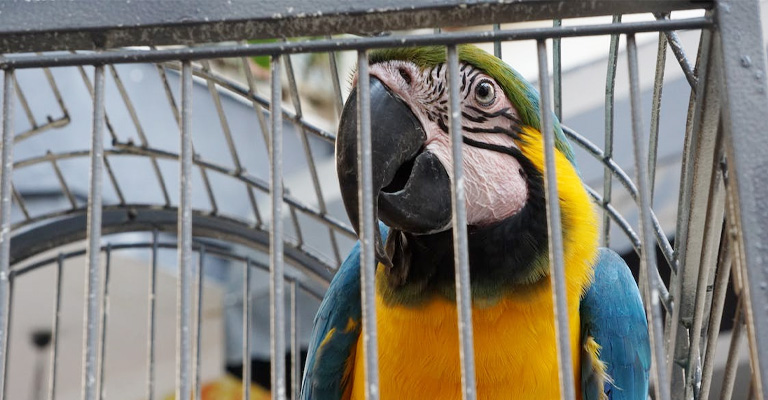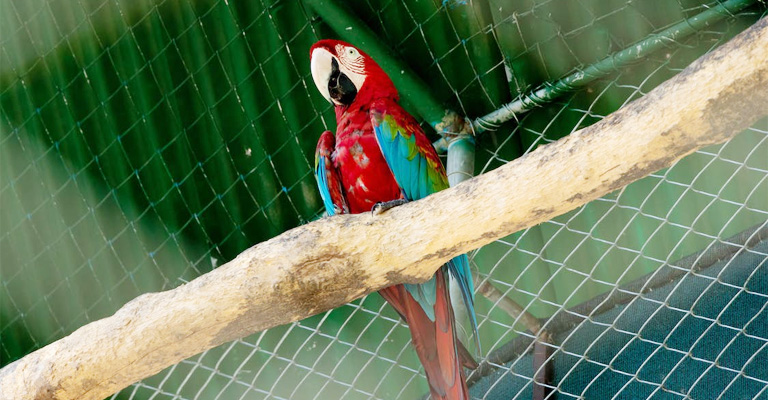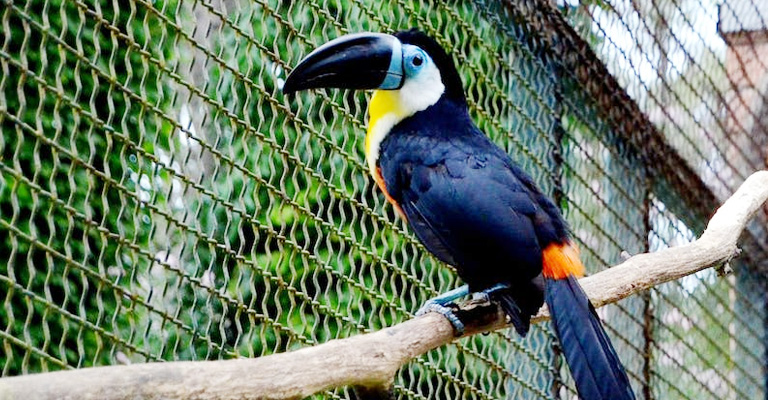The poignant lyrics of Maya Angelou’s poem “Caged Bird” remind us that even within confinement, the caged bird still sings.
This profound metaphor extends beyond literature, encapsulating the resilience and indomitable spirit that birds exhibit even in captivity.
The question of why does the caged bird song delves into the depths of their nature, exploring the instinctual need to communicate, assert territory, or find solace through melodious expressions.
Despite being removed from their natural habitats and freedom, caged birds create a symphony that speaks to their unwavering spirit and the profound connection they maintain with the world beyond their bars.

Why Does The Caged Birds Song?
Here are some logical reasons why the caged bird sings:
Instinctual Communication
Singing is a natural instinct for birds, even in captivity. The caged bird’s song is an inherent form of communication that reflects its need to interact with its surroundings.
Just as wild birds sing to communicate with others, caged birds continue to use their song to express their presence, emotions, and intentions.
Territorial Assertion
Caged birds might sing to establish their territory, a behavior deeply ingrained in their instincts.
This territorial song marks their domain, even within the confines of their cage, and sends a message to other birds that this space is occupied.
Emotional Expression
Caged birds, like their wild counterparts, experience emotions. Singing can be an outlet for emotional expression, allowing them to communicate their feelings of happiness, contentment, or even frustration, which can arise from their confinement.
Imitation and Learning
Caged birds are exceptional mimics and learners. They might imitate sounds from their surroundings, including human speech, melodies, and even electronic noises. This mimicry is a way for them to engage with their environment and integrate the sounds they hear.
Seeking Attention

Caged birds are often social creatures that thrive on interaction. Singing can be a way to seek attention from human caregivers or other animals in the household. Their song becomes a method of communication to solicit interaction and companionship.
Captive Comfort
In the absence of natural cues, the caged bird’s song can provide them with a sense of comfort.
Singing helps them establish a routine and brings a sense of familiarity, providing them with a semblance of control over their environment.
Coping Mechanism
Singing can serve as a coping mechanism for the challenges of captivity. It offers an emotional outlet and occupies their minds, helping them manage boredom, frustration, and the limitations of their confined space.
In essence, the caged bird’s song reflects a complex interplay of natural instincts, emotional responses, and adaptability to a captive environment.
It’s a reminder that even within constraints, the spirit of these creatures can find expression in the form of a song that resonates far beyond their physical enclosure.
Why Does The Caged Bird Sing The Song Full Of Fear?

Here are some possible reasons why the caged bird sings the song full of fear:
To Express Its Feelings And Emotions
One reason why the caged bird sings the song full of fear is to express its feelings and emotions, such as sadness, anger, or longing.
The caged bird is trapped and confined in a small space, deprived of its natural habitat and freedom. Singing is a way for the caged bird to release its pent-up emotions and cope with its situation.
To Stay Motivated And Hopeful
Another reason why the caged bird sings the song full of fear is to stay motivated and hopeful, despite its circumstances.
The caged bird dreams of flying in the open sky, where it belongs. Singing is a way for the caged bird to remind itself of its true nature and potential and to keep alive its hope of escaping one day.
To Inspire Others
A third reason why the caged bird sings the song full of fear is to inspire others, especially those who are in similar situations or face similar challenges.
The caged bird’s song is heard from a distant hill, where it reaches the ears of other birds or animals who may be suffering from oppression or injustice.
Singing is a way for the caged bird to share its message of freedom and courage and to encourage others to resist and fight for their rights.
To Protest Against Its Captors
A fourth reason why the caged bird sings the song full of fear is to protest against its captors, who have taken away its liberty and dignity.
The caged bird’s song is a form of resistance and defiance, challenging the authority and power of those who have imprisoned it.
Singing is a way for the caged bird to assert its identity and voice and to demand justice and respect.
To Cope With Boredom And Loneliness
A fifth reason why the caged bird sings the song full of fear is to cope with boredom and loneliness, which are common effects of captivity.
The caged bird has no companionship or stimulation in its cage and may feel isolated and depressed. Singing is a way for the caged bird to entertain itself and create some variety in its dull and monotonous life.
To Attract Attention And Help
A sixth reason why the caged bird sings the song full of fear is to attract attention and help from others who may hear its song.
The caged bird may hope that someone will notice its plight and come to its rescue or at least offer some sympathy or comfort.
Singing is a way for the caged bird to communicate its distress and desperation and to seek some assistance or relief.
To Imitate Other Birds
A seventh reason why the caged bird sings the song full of fear is to imitate other birds that it hears outside its cage.
The caged bird may try to mimic the songs of free birds that fly by or perch nearby as a way of learning from them or connecting with them.
Singing is a way for the caged bird to emulate other birds’ behaviors and skills and to feel some sense of belonging or kinship.
To Exercise Its Vocal Cords
An eighth reason why the caged bird sings the song full of fear is to exercise its vocal cords, which are essential for its survival and well-being.
The caged bird may not have many opportunities to use its voice in captivity, which may affect its health and happiness.
Singing is a way for the caged bird to keep its vocal cords in good shape and condition and to prevent them from atrophying or deteriorating.
To Create Beauty
A ninth reason why the caged bird sings the song full of fear is to create beauty in a world that seems ugly and cruel. The caged bird may find some solace and joy in creating music that transcends its suffering and pain.
Singing is a way for the caged bird to express its creativity and artistry and to make something beautiful out of something horrible.
What Is The Origin Of The Phrase ‘Caged Bird Sings’?

The phrase ‘caged bird sings’ is most famously associated with the American writer Maya Angelou, who used it as the title of her first autobiography, I Know Why the Caged Bird Sings, published in 1969.
The book chronicles her life from age 3 through age 16, recounting an unsettled and sometimes traumatic childhood that included rape and racism. It became one of the most widely read and taught books written by an African American woman.
However, the phrase ‘caged bird sings’ was not originally coined by Angelou but by another African American poet, Paul Laurence Dunbar, who wrote a poem called Sympathy in 1899.
The poem expresses the feelings of a Black person who suffers from racial discrimination and oppression in America. The poem contains the famous lines:
I know why the caged bird sings, ah me, When his wing is bruised and his bosom sore, When he beats his bars, and he would be free; It is not a carol of joy or glee, But a prayer that he sends from his heart’s deep core, But a plea, that upward to Heaven he flings— I know why the caged bird sings.
Angelou was inspired by Dunbar’s poem and used it as an epigraph for her autobiography.
She also borrowed the title of the poem for her own poem, Caged Bird, which she wrote in 1983. The poem compares the experiences of a free bird and a caged bird and reflects on the themes of freedom and captivity. The poem repeats the line:
The caged bird sings with a fearful trill of things unknown but longed for still.
The phrase ‘caged bird sings’ has become a powerful symbol of the struggle and resilience of African Americans and other oppressed groups in history and society.
The phrase has also been used in other works of art and culture, such as songs, movies, and books.
FAQ
Caged birds sing for various reasons, including communication, territorial assertion, and emotional expression. Singing is a natural behavior deeply ingrained in their instincts and serves as a means to interact with their surroundings.
Caged birds’ songs can differ from those of their wild counterparts due to the absence of natural environmental cues. They may mimic human sounds or incorporate elements from their captive environment into their songs.
Yes, some caged birds sing as a way to attract potential mates. This behavior is an instinctual part of their courtship rituals, even if they don’t have the opportunity to physically interact with other birds.
Caged birds’ songs can evolve and change due to exposure to new sounds, interactions with humans, or adjustments to their environment. They may incorporate novel sounds into their repertoire or adapt their songs based on their experiences.
Sometimes, caged birds might sing out of frustration or boredom. This can be a way for them to cope with the limitations of their confinement, as singing offers a mental and emotional outlet in an otherwise restricted setting.
Conclusion
In the resonant melodies of the caged bird, we witness a testament to the unyielding power of life’s innate yearnings.
Their song, in the face of captivity’s constraints, encapsulates the enduring spirit that transcends barriers. From asserting territory to seeking companionship, these tunes echo the complex tapestry of emotions and instincts that define avian existence.
The caged bird’s song serves as a poignant reminder of the beauty that remains unextinguished, even in the most adverse circumstances.
In each note, we find a paradox of longing and resilience, a delicate yet potent reminder that freedom, though stifled, can find its voice in the form of a song that travels far beyond the confines of a cage.